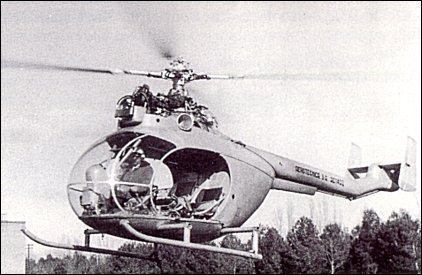
| Aerotecnica AC.14 1956 |  |
 |

| Aerotecnica AC.14 1956 |  |
 |
|
The AC-14 is an enlarged version of the AC-13, powered by a Turbomeca Artouste II shaft turbine and with accommodation for five persons in its passenger-carrying role. It is available also as an agricultural and ambulance aircraft. As in the AC-12, the engine is mounted above the cabin, which is extensively sound-proofed. Residual thrust is used to increase forward speed, leaving the movable tail fins to provide anti-torque and directional control. Six AC-14's are being built by the ENHASA company, of which the first flew for the first time on July 16, 1957. TYPE: Five-seat single-rotor Helicopter. ROTOR: Four-blade rotor with double-articulated blades of similar construction to those of AC-12. Rotor blade area each 0.84m2. Rotor disc area 72.35m2. Anti-torque control by gas deflection in helicopter flight and by vertical rudders in gyrodyne flight (high speed cruising). ROTOR DRIVE: The main rotor is driven directly from the turbine gear-box through a universal joint. FUSELAGE: Light alloy structure. LANDING GEAR: Skid type. Track of skids 2.0m. POWER PLANT: One Turbomeca Artouste IIB shaft-turbine, developing 400hp. Fuel tank under seats with capacity of 74 litres in agricultural version and 244 litres in passenger-carrying version. Oil capacity 9.4 litres. ACCOMMODATION: Enclosed cabin seating pilot at the front and four passengers in two side-by-side pairs behind. Entrance door on each side of cabin. Jane's All the World's Aircraft, 1959-60
Cantinieau had also been working on another project for a three-seat turbine-powered helicopter, the designs for which he had sold to SNCAN. The layout of this machine was very close to that of the AC.12. SNCAN built two prototypes of this helicopter as the Nord N.1750 "Norelfe" which was a rather futuristic all-metal machine with a large bubble canopy and a Turbomeca Artouste I turbine mounted above and behind the cockpit. The three-blade rotor was positioned directly over the engine and had a rotorhead enclosed in a large spherical fairing. The tail rotor was replaced by a ducted exhaust gas arrangement similar to that employed forty years later on the McDonnell Douglas NOTAR designs. This was controlled by the pilot through pedals. The three-seat Norelfe prototype, F-WGVZ, was flown on 28 December 1954 but SNCAN was occupied with other projects and sold both the aircraft and the rights to Aerotecnica who designated them AC.13A. After further testing in Spain, Aerotecnica moved to a larger five-seat version known as the AC.14. The prototype AC.14 used part of the structure of one of the AC.13s but had a lengthened cabin section with a rear seating area and a larger 400shp Turbomeca Artouste IIB turboshaft engine. Having funded much of the Aerotecnica helicopter project, the Spanish Government placed orders for twelve examples of the piston engined AC.12 and ten of the AC.14. These were delivered to the Spanish Air Force, with the designations EC-XZ-2 and EC-XZ-4 respectively, where they served for a relatively short period before being retired. Aerotecnica also started construction of a prototype of the much larger AC.21 which was a 12/14 passenger machine with twin Turbomeca Turmo III turbines and a massive ducted-air tailboom. A turbine version of the AC.12 was planned and they also started working on the AC.15 development of the AC.14 with a 260hp Lycoming O-435-V engine. Unfortunately, in 1962 the Spanish Government withdrew further financial support and Aerotecnica went into liquidation. Following the collapse of Aerotecnica, Jean Cantinieau returned to France where he joined Matra. There, he designed and completed a single example of the "Bamby". This single-seat machine closely resembled the Aerotecnica machines but embodied a triangular end to the tailboom which provided a better direction and control of exhaust gas. After brief testing in 1963 the "Bamby" suffered a power train failure and was abandoned. R.Simpson "Airlife's Helicopter and Rotorcraft", 1998
|